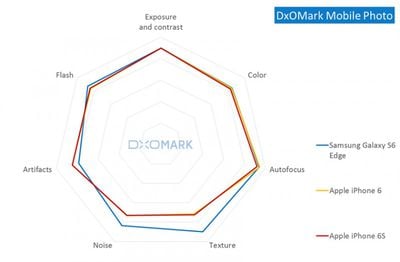In a new review for the iPhone 6s, DxOMark concluded that the camera on the 2015 iPhone line deserved a score of 82, equal to that of the score it gave for the iPhone 6 one year ago. The website measured seven factors (exposure and contrast, color, autofocus, texture, noise, artifacts, and flash) to determine an overall score for the camera on the iPhone 6s, giving the lowest marks to texture and noise (via CNET).

From our tests, images are generally well-exposed and for the most part colors are vivid and pleasing outdoors. However, there are occasional differences in exposure noticeable between consecutive captures in very bright outdoor scenes, typically due to the inconsistent activation of the HDR mode.
There is also a slight but consistent underexposure in extremely low light levels (5 lux); the result however is still quite usable and an improvement over the iPhone 6. White balance is reliable though inevitably some inaccuracies were noticeable at times, with a slight yellow cast visible in some outdoor scenes. Although this cast was present in captures from the iPhone 6 the cast was slightly stronger and more noticeable on the 6s.
A score of 82 is the same as the iPhone 6 in 2014, but also behind the 87 given to the Sony Xperia Z5 and the 86-scoring Samsung Galaxy S6 Edge. Apple's rivals also won in a series of similar video tests, scoring between four and six points higher than the 80 awarded to the iPhone 6s.
DxOMark's closing statement regarding the new iPhone line is a bit similar to the overall consensus found elsewhere online regarding the iPhone 6s and iPhone 6s Plus. The French optics and image processing firm described the smartphone as a "good balance of performance and top-notch user experience," but not an entirely compelling upgrade from an iPhone 6 or 6 Plus, especially when considering solely the camera and video tests conducted by the firm.
























Top Rated Comments
This means the picture is just as good as before, except you can crop it more without worrying about loosing detail, or you can zoom further in after taking the photo than you could before.